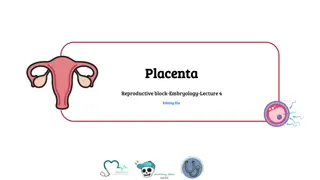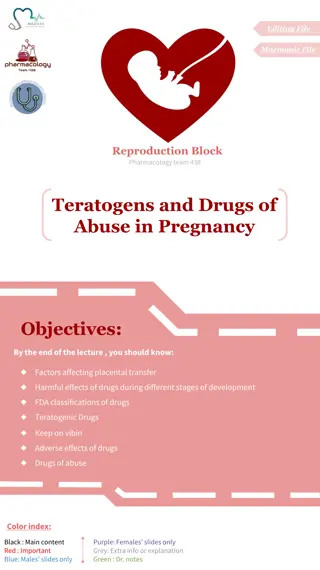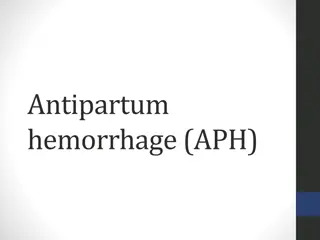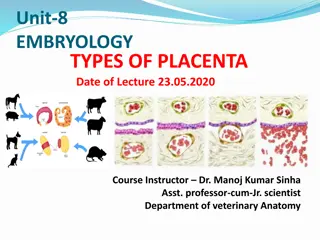
Retained Placenta: Types, Risks, and Treatment
Learn about the definition, types, risks, and treatment of retained placenta. Discover the potential complications and how to diagnose this serious postpartum condition effectively to prevent severe health issues for mothers.
Download Presentation

Please find below an Image/Link to download the presentation.
The content on the website is provided AS IS for your information and personal use only. It may not be sold, licensed, or shared on other websites without obtaining consent from the author. If you encounter any issues during the download, it is possible that the publisher has removed the file from their server.
You are allowed to download the files provided on this website for personal or commercial use, subject to the condition that they are used lawfully. All files are the property of their respective owners.
The content on the website is provided AS IS for your information and personal use only. It may not be sold, licensed, or shared on other websites without obtaining consent from the author.
E N D
Presentation Transcript
StudyMafia.Org Retained Placenta Submitted To: Submitted By: Studymafia.org Studymafia.org
Table Contents Definition Introduction Types of Retained Placenta Risks of Retained Placenta Diagnosis of Retained Placenta Treatment of Retained Placenta Complications of Retained Placenta Conclusion 2
Definition A retained placenta is when the placenta is not delivered within 30 minutes of the baby's birth. It is a serious problem since it can lead to severe infection or life-threatening blood loss. 3
Introduction Labor occurs in three stages: The first stage is when you begin to experience the contractions that cause changes in your cervix to prepare for delivery. The second stage is when your baby is delivered. The third stage is when you deliver the placenta, the organ responsible for nourishing your baby during pregnancy. 4
Types of Retained Placenta Placenta Adherens Placenta adherens is the most common type of retained placenta. occurs when the uterus, or womb, fails to contract enough to expel the placenta. Instead, the placenta remains loosely attached to the uterine wall. 6
Types of Retained Placenta Trapped Placenta A trapped placenta occurs when the placenta detaches from the uterus but doesn t leave the body. This often occurs because the cervix starts to close before the placenta is removed, causing the placenta to become trapped behind it. 7
Types of Retained Placenta Placenta Accreta Placenta accreta causes the placenta to attach to the muscular layer of the uterine wall rather than the uterine lining. This often makes delivery more difficult and causes severe bleeding. If the bleeding can t be stopped, blood transfusions or a hysterectomy may be required. 8
Risk of Retained Placenta Factors that can increase your risk of a retained placenta include: being over age 30 giving birth before the 34thweek of pregnancy, or having a premature delivery having a prolonged first or second stage of labor having a stillborn baby 9
Diagnosis of Retained Placenta A doctor can diagnose a retained placenta by carefully examining the expelled placenta to see if it s still intact after delivery. The placenta has a very distinct appearance, and even a small missing portion can be cause for concern. 10
Diagnosis of Retained Placenta In some cases, however, a doctor may not notice that a small part is missing from the placenta. When this occurs, a woman will often experience symptoms soon after delivery. If your doctor suspects you have a retained placenta, they ll perform an ultrasound to look at the womb. 11
Treatment of Retained Placenta Treatment for a retained placenta involves removing the entire placenta or any missing parts of the placenta. It can include the following methods: Your doctor may be able to remove the placenta by hand, but this carries an increased risk of an infection. They may also use medications either to relax the uterus or to make it contract. This can help your body get rid of the placenta. 12
Treatment of Retained Placenta In some cases, breast-feeding can also be effective because it causes your body to release hormones that make your uterus contract. You doctor may also encourage you to urinate. A full bladder can sometimes prevent the delivery of the placenta. If none of these treatments help the body expel the placenta, your doctor may need to perform emergency surgery to remove the placenta or any remaining pieces. 13
Complications of Retained Placenta Delivering the placenta is an important step in allowing the uterus to contract and to stop more bleeding from occurring. If the placenta isn t delivered, the blood vessels where the organ is still attached will continue to bleed. Your uterus will also be unable to close properly and prevent blood loss. 14
Conclusion A retained placenta is a rare complication of pregnancy that can be treated effectively once it s diagnosed. Taking steps to correct the problem quickly can result in a favorable outcome. If you re at risk for a retained placenta or if you have experienced a retained placenta in the past, discuss any concerns you have with your doctor before giving birth. 15
References Google.com Wikipedia.org Studymafia.org Slidespanda.com
Thanks To StudyMafia.org






















